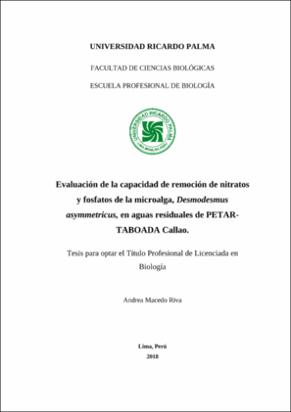| dc.description.abstract | La contaminación de fuentes hídricas por diferentes actividades, entre ellas las aguas residuales, es una problemática que ha incrementado por el crecimiento poblacional e industrial. Se han desarrollado diferentes fases en su tratamiento, necesitando un tratamiento terciario con procesos fisicoquímicos que resultan costosos; sin embargo, una alternativa interesante es el empleo de microalgas como biosistema, debido a su capacidad de capturar cantidades significativas de Nitratos y Fosfatos durante su crecimiento. Es así que, en el primer semestre del 2017, se evaluó la capacidad de remoción NO3- y PO43- de la microalga D. asymmetricus en aguas residuales de la Planta de Tratamiento la TABOADA y a su vez, se buscó reconocer si esto se ve influenciado por la limitación de nutrientes (72 hrs). Se utilizaron dos tratamientos, T4 (inóculo + agua residual) y T5 (inóculo estresado + agua residual), para cada uno, se acondicionó por quintuplicado cultivos de 7L con una proporción de 1:1 (inóculo: agua residual) por un periodo de 10 días, fotoperiodo 12:12 y aireación constante. El efecto del estrés por limitación de nutrientes fue monitoreado en términos de crecimiento y remoción a través de pruebas de densidad celular, biomasa seca, porcentaje y tasa de remoción de nitratos (NO3-) y fosfatos (PO43-). La microalga D. asymmetricus cultivada en agua residual nitrógeno limitada (N/P=11.6), demostró un buen crecimiento en un periodo de 10 días, evidenciado en una densidad celular de 10.37 ± 2.78 x106 cel.mL-1 en el T4, equivalente a un aumento de 9 veces el valor inicial; así mismo en T5 se obtuvo uno de los mayores valores de biomasa algal (1 759 ± 342.6 mg.L-1), además, tanto para NO3- y PO43- se apreció mayor velocidad de absorción hasta el tercer día de experimentación, removiendo más del 90% de la concentración, siendo el mayor porcentaje de remoción final para NO3- en T5 (95.4 ± 5.7%), mientras que para PO43- en T4 (98.9 ± 1.4%), también observando que el tratamiento de limitación de nutrientes de 72 horas no ocasionó efectos significativos sobre la capacidad de remoción de la microalga. En conclusión D.
asymmetricus demostró su capacidad potencial de remediador en aguas residuales domésticas.
The pollution of water sources by different activities, including wastewater, is a problem that has increased due to population and industrial growth. Different phases have been developed in its treatment, requiring a tertiary treatment with physicochemical processes that are costly; however, an interesting alternative is the use of microalgae as a biosystem, due to its capacity to capture significant amounts of Nitrates and Phosphates during its growth. Thus, in 1st semester of 2017, the removal capacity of NO3- and PO43- of the microalga D. asymmetricus in wastewater from the TABOADA Treatment Plant was evaluated and in turn, it was recognized if this was influenced by the starvation period (72 hrs.). Two treatments were used, T4 (inoculum + wastewater) and T5 (stressed inoculum + wastewater), for each one, 7L cultures with a ratio of 1: 1 (inoculum: wastewater) for a period of 10 days, photoperiod 12:12 and constant aeration were conditioned by quintuplicate. The effect of stress due to starvation period was monitored in terms of growth and removal through tests of cell density, dry biomass, percentage and removal rate of nitrates (NO3-) and phosphates (PO43-). The microalgae D. asymmetricus cultivated in nitrogen-limited wastewater (N/P= 11.6), showed a good growth in a period of 10 days, evidenced in a cell density of 10.37 ± 2.78 x106 cel.mL-1 in T4, equivalent to an increase of 9 times the initial value; likewise, in T5, one of the highest values of algal biomass was obtained (1 759 ± 342.6 mg.L-1), in addition, both for NO3- and PO43- higher absorption rate was observed up to the third experimentation day, removing more 90% of the concentration, being the highest percentage of final removal for NO3- in T5 (95.4 ± 5.7%), while for PO43- in T4 (98.9 ± 1.4%), also observing that the starvation treatment of 72 hours did not cause significant effects on the microalga removal capacity. In conclusion D. asymmetricus demonstrated its potential remedial capacity in domestic wastewater. | es_ES |


